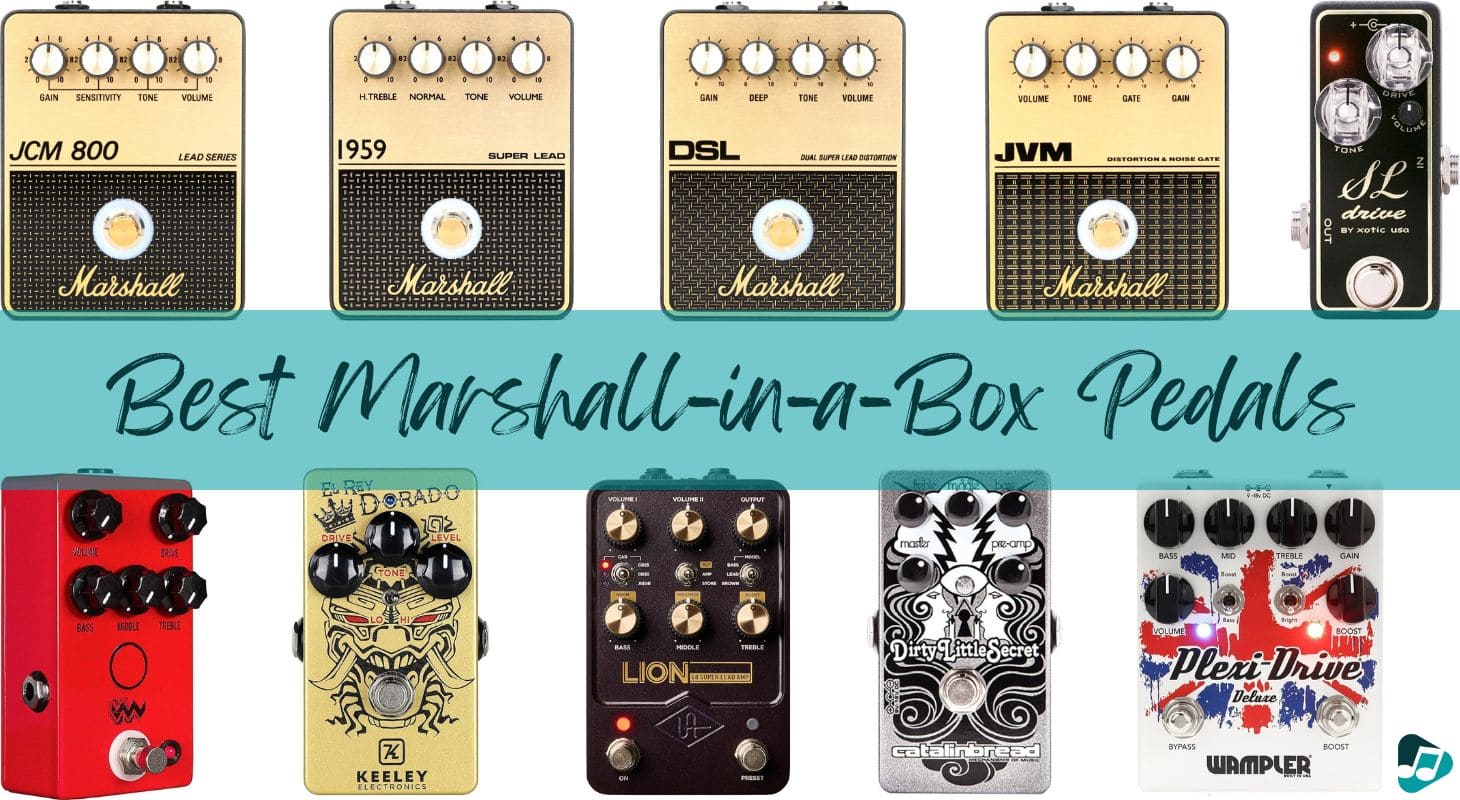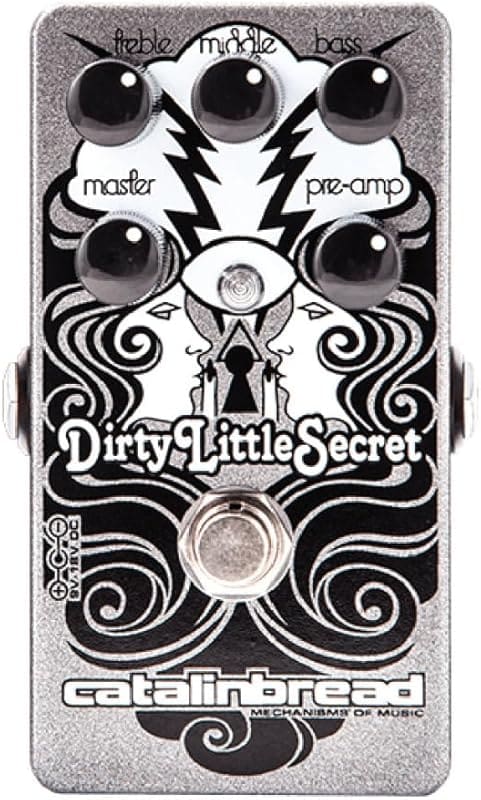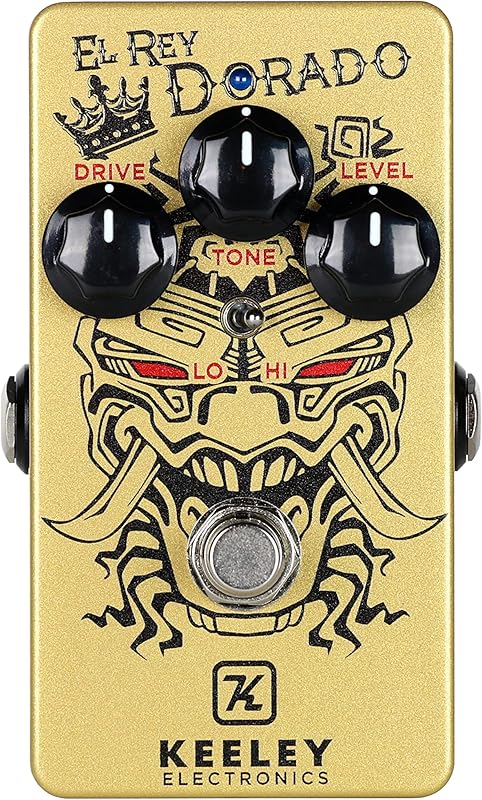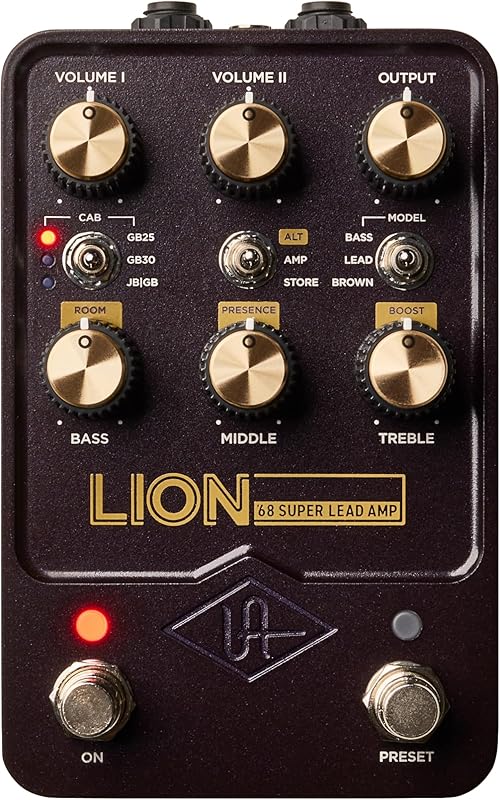Marshall is the synonym of a badass rocking tone. Yes, from the Jimi Hendrix Experience to Motorhead to Kiss, the Red Hot Chili Peppers, AC-DC, Joe Satriani, and Eric Clapton, the Marshall logo has seen more stages than any living person.
Yet not all of us can proudly walk into a venue where roadies have already set up our Marshall full stacks. That’s a treat only a few guitarists can enjoy. Most of us just pivot between a small combo and a digital amp going into the PA.
So, how can we capture the tone and fierce power of unleashed Marshall heads cooking and overdriving? The brown sound has made it to the pedal world and spawned some replicas that ooze tone and compel you to rock, roll, headbang, and let your spirit loose.
Top 3 - Marshall-in-a-Box Pedals
Preview | Product | Price |
|---|---|---|
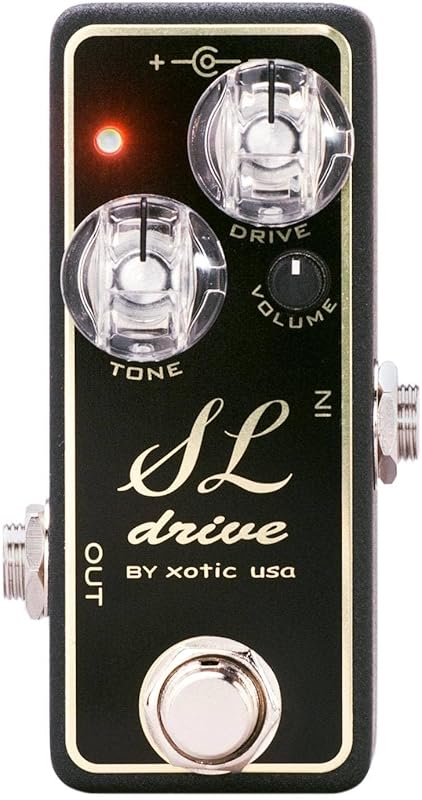 | ||
 |
I did the hard work for you and spent days trying Marshall-in-a-box pedals to narrow the choices to only the best in the market.
Without further ado, here are the best pedals to play the Marshall tone anywhere.
What’s the Brown Sound, anyway?
It all started with a misunderstanding.
Eddie Van Halen is said to be not only the creator of the Brown Sound but also the one who named it. In science, the term for seeing colors when you hear sounds is called synesthesia.
When asked about this by Billboard, Eddie said “That’s funny, because people took that whole “brown sound” thing totally out of context. I was never talking about my guitar tone. I was talking about Alex’s snare drum.” Alex is the other Van Halen in the band, his brother.
But then, after saying that, he condensed the idea of the Brown Sound better than any of us ever could. He said, “I’ve always thought Alex’s snare drum sounds like he’s beating on a log. It’s very organic.” Then, when asked about why he called it brown, he added, “I don’t know. It’s an organic sound. Brown is an organic color.”
That’s the definition of the Brown Sound, very often associated with souped-up Marshalls. It’s this lush, organic, warm, and immense sound with liquid-like sustain and an insane amount of gain that stays articulate and clear while being crushingly powerful.
This was back in 1978, and Eddie had to crank a 100-watt Marshall head and perform all kinds of tricks to get it to distort that much.
Using that rig to get that sound is, again, a privilege of a few. That said, guitar playing was forever changed after that first Van Halen album, and most brands and rockers have been chasing that uncanny sound ever since.
What Do We Talk About When We Talk About Marshall-in-a-Box?
Well, one thing everybody agrees upon when talking about the Brown Sound is that it has to come from over-the-edge EL34 power tubes. These are mammoth 25-watt valves that are stock in most Marshall amps. In a way, they’re the English version of the 6L6s most US-made amps use.
So, a Marshall-in-a-box pedal is a device that tries to emulate the natural, organic, lush saturation of a pushed Marshall valve amp without the real thing. These are often very responsive, percussive, powerful pedals that can go from dirty to complete mayhem at the twist of a knob.
They encapsulate the legendary Brown Sound in a device that can fit the palm of your hand.
Best Marshall in a Box Pedals
1. Marshall Pedals
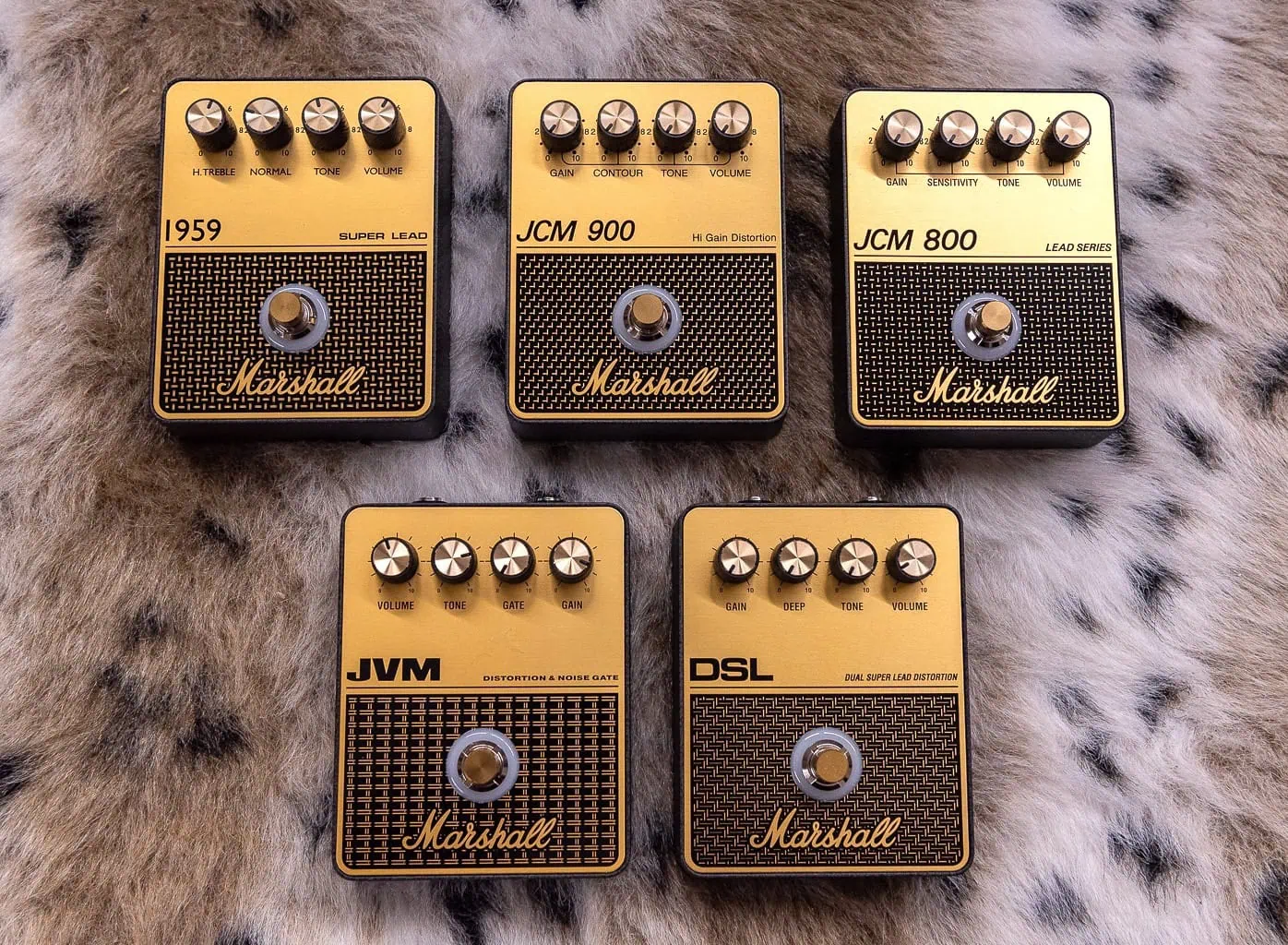
Marshall surprised everyone in NAMM 2025 when they dropped a full lineup of new pedals made after their most iconic amps. I mean, one thing is any brand making a Marshall-like pedal, and a very different one is Marshall itself doing it.
This new series has five models that emulate five legendary amps, the 1959, the JCM800, the JCM900, the DSL, and the JVM.
1959
Let’s start with the 1959. It was an amazing surprise. It features Hi Treble, Normal, Tone, and Volume controls. If you set everything at noon and the Hi Treble and Normal at about nine o’clock, what you have is that fat, punchy, warm sound this head is famous for.
I loved it with the Hi Treble at three o’clock and the Normal at nine o’clock. It became creamy, punchy, fat, and very brown. It had that Eddie thing. Moreover, pushing the Normal to noon, you have some Randy Rhoads.
With everything cranked, it unleashes hell but loses some of its tight low end.
JCM800
The JCM800 has more confusing controls because it sports a Gain and a Sensitivity control. This is a blend between the 800’s classic low and high inputs. Other than that, you have Tone and Volume that work as you’d expect.
The clean setting, (Gain and Sensitivity at around nine o’clock) is pushy with generous midrange but not overly distorted. You no longer have that massive warmth and bottom end, but everything is much tighter and rocking.
If you push the Gain up to three o’clock you get this dirty bluesy tone that’s very usable. Think, clean Gary Moore. I liked it best with Gain and Sensitivity at three o’clock; it became a roaring beast. I was doing my best Motley Crüe in a second.
With Gain and Sensitivity cranked you lose some definition but get a lot of gain, enough to make the Earth tremble.
JCM900
The JCM900 comes with a Contour control that sweeps the midrange to get that fully scooped sound. I loved it with that control around eleven o’clock and the gain at three o’clock. It gave me that Dave Navarro thick distortion with lots of definition and character.
DSL
The trick with the DSL is finding the sweet spot for the Deep knob. It does the same as the Deep knob in the actual amp does, enlarging the low end. Well, in this pedal it can turn a small combo in a bedroom into a roaring stack (sort of), but it can be too much if you’re running it into a 2x12 or even a 4x12.
Other than that, this is clearly a distortion pedal capable of going from rock to metal and everything in between.
JVM
Finally, the JVM is everything you would expect. The real deal is a three-channel amp, and this pedal does it all too. The gain and volume knobs are inverted compared to the rest of the line and you can have some crunchy rock with the gain at nine o’clock and full-on warzone with the gain beyond three o’clock.
Meanwhile, you can get rid of the hiss or go for a full-on staccato thing (think Static X, Mudvayne, and such) by playing with the gate knob. It really is a powerful one and the pedal goes dead silent when you stop playing.
All the pedals in this line are heavy metal bricks finished in righteous gold. They can be used with a 9-volt battery or an AC adapter and feature a light under the switch that engages when the pedal is ON.
I would say that if you’re looking for the true Marshall tone, one of these must fit the bill. That said, they’re big and bulky, so not too pedalboard-friendly.
2. Xotic SL Drive
This pedal looks like a magic trick. If you were to hear it before seeing it, you would never believe that such a thick, fat distorted tone comes from such a tiny unit.
Well, Xotic did it again, folks, they knocked it out of the park with this one too.
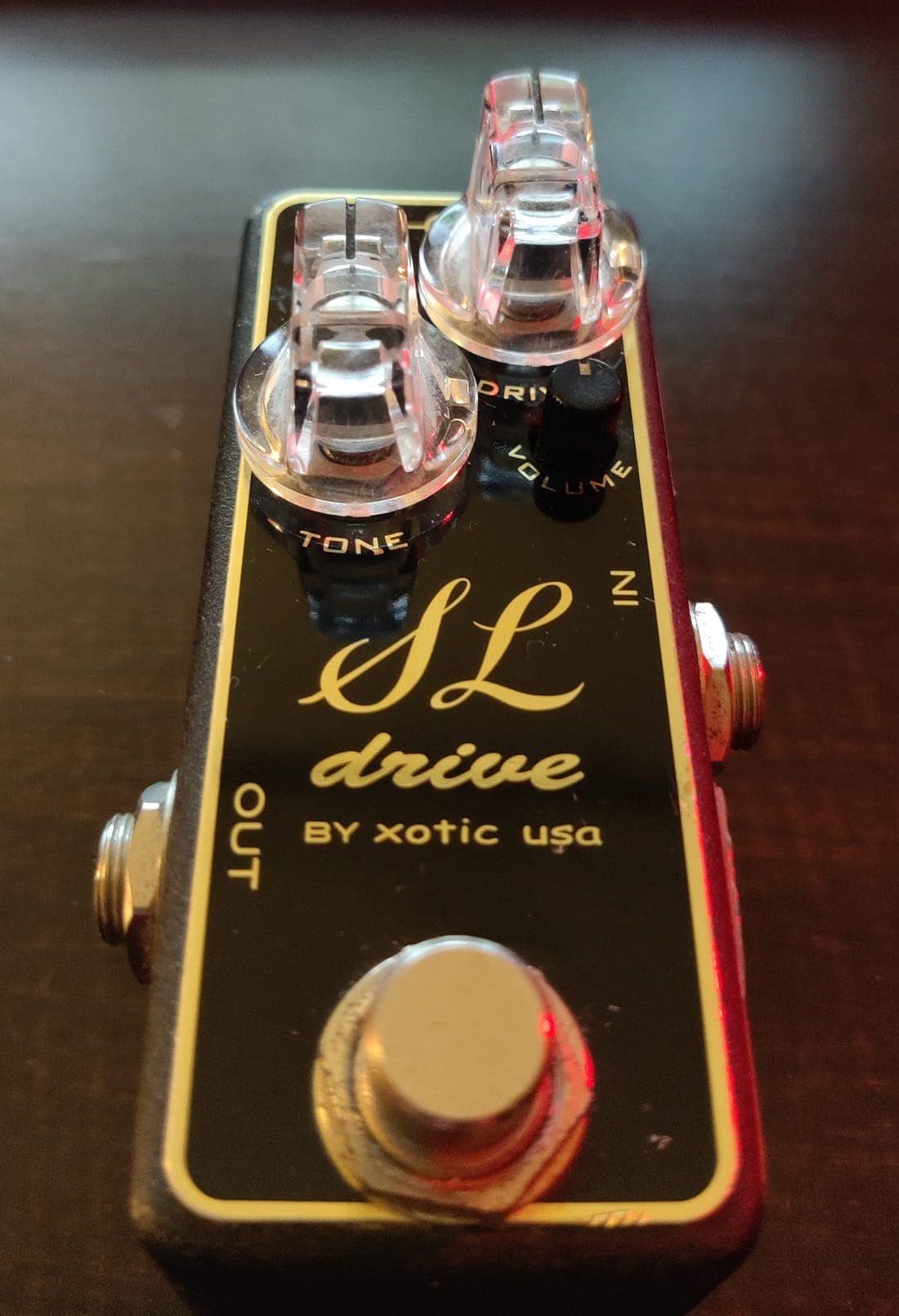
Xotic SL Drive
To begin with, let me say that the size of this pedal is very convenient and in line with modern guitarists’ needs. Yes, it takes almost zero pedalboard real estate, and it can help you play an entire show.
Size is a double-edged sword because you can’t use it on batteries, and it has some hidden switches that require you to open the pedal to modify them.
But let’s get to the fun part, how does this little thing sound?
It’s made to mimic the big, warm, thick, and organic sound of the 1959 Super Lead. Now, although it’s made after that classic amp, it’s got way more gain at hand than the real thing. Furthermore, I would say that, with the gain halfway up, you are already in JCM800 territory.
Although the gain structure might be different, it never loses the percussiveness, the lush sustain, the reactive quality of your playing, and the tight bottom end.
I tried it alone at first with my Ibanez Studio and its mighty humbuckers and the result was instant AC-DC with the gain set to low and instant Gary Moore with more juice. But the setting I loved the most was going into the Tube Screamer and then hitting the SL with a slightly driven tone. The mids got fuller and the tone rounder.
Those two are a match made in heaven.
I then moved on to single-coil guitars and it sounded gloriously raw and unapologetic with my Telecaster. I went through everything from The Clash to Ritchie Kotzen. Furthermore, the P-90 of my SG Jr. gave this pedal even more midrange to bite with, so the tone became sharp and huge. You can think of something like “Barracuda” by Heart but on steroids (lots of steroids).
Finally, the EQ with the inner sliders is a must because the pedal really changes its tone with those tone-shaping switches. I loved it with everything on but going from one guitar to another might make you want to change them on the fly. I hope they come with a version that has them on the outside soon.
The SL Drive is perfect for cramped pedalboards and guitarists who want to sound like a souped-up Marshall with fat, creamy, organic tones.
3. Wampler Plexi-Drive Deluxe
The Wampler Plexi Drive Deluxe is one of the most versatile pedals on this list. I know, it says Plexi Drive on its forehead, but believe me, this pedal can do much more than that.
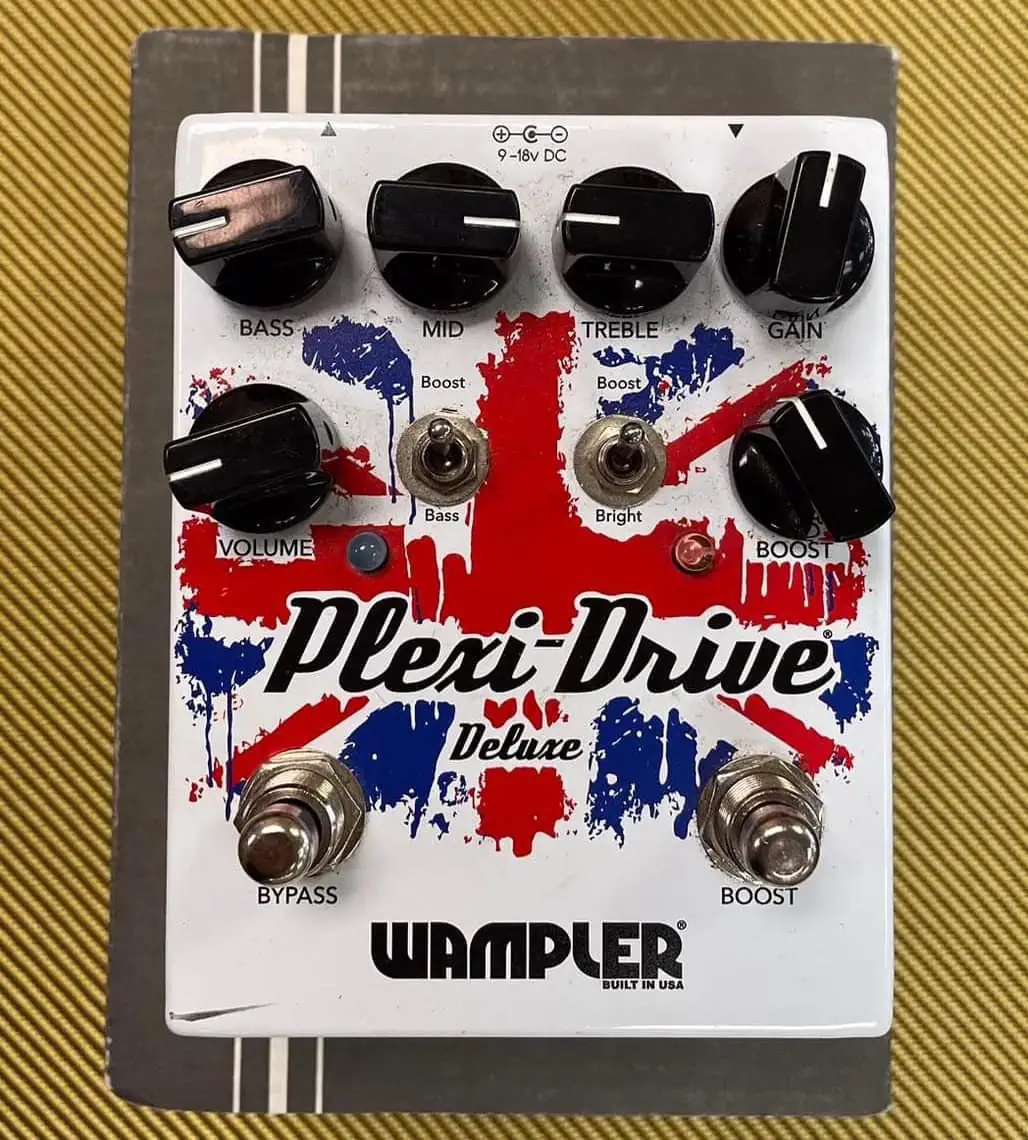
Wampler Plexi-Drive Deluxe
To begin with, this was one of the first models Brian Wampler ever designed for the brand and it hides one amazing secret under the hood; all EQ controls are active.
“What does that mean, bro?” I can almost hear you asking me. Well, it means that it can cut frequencies but also boost frequencies. So, when everything is set to noon, EQ is neutral, but above noon you’re moving that frequency range forward in the mix.
I’ll tell you how to use it to your advantage in a minute, but let’s go over the controls first.
As I said, it has a very capable 3-band EQ, a volume, and a gain knob. The additional knob is only for the booster and doesn’t affect the Plexi tone. Bear in mind that both sides of this pedal are independent, and you can use them as two different pedals.
Besides the knobs, this pedal features two toggle switches to turn on the bass and the treble boosts. These add either another dimension of low-end to the resulting sound or natural, musical, singing highs to whatever you play.
I started my test with single coils and everything at noon. I was instantly into Hendrix territory. The percussiveness of Jimi’s sound was right there. Moreover, playing into an open-back combo, the bass boost became really handy making it sound like a 4x12.
Furthermore, I fell in love with the midrange in the EQ. Although it’s not such a pleasant sound on its own, if you crank those mids, you can cut through any mix and make yourself heard even if two more guitarists are doing their thing.
Moving over to humbuckers and giving the pedal some more meat from the gain section (the knob at around three o’clock) I was instantly into hard rock, pop punk, or alternative music territory. Moreover, the grain of the distortion and that organic, pick-sensitive, responsive nature of the pedal scream Marshall in every direction possible.
But what about the other side of the pedal? Well, the other side is very close to a Tube Screamer but built into the pedal and with only one control. That’s kind of a bummer because it changes the overall tone when engaged. I mean, don’t get me wrong, it’s a nice way to change it because it adds those beautiful mids any TS pedal would, but if that’s not your cup of tea (or beer brand in this case), there’s absolutely no way to tweak it.
I tried it on its own and it sounds amazing to my ears (I’m a confessed TS fan, sorry about that). It’s not so clean, especially when you push it, but makes an outstanding overdrive sound to bring mayhem stepping on the other side.
Furthermore, if you happen to have a mildly overdriven amp, you can have three gain stages using just one pedal.
I only wish you could change the settings on the boost side. Other than that, this is a terrific do-it-all-box ready to conquer the world on the right pedalboard.
4. Catalinbread Dirty Little Secret
Catalinbread’s take on the Marshall-in-a-box thing is quite impressive. Let me tell you that it packs almost as much punch per square inch as the SL Drive does, and it’s twice as big!
But I’m getting ahead of myself here.
To begin with, this pedal is small and sturdy, and it seems to be ready to hit the road. I love metal enclosures and good-quality switches. This device checks both boxes.
I turned it on and played it with everything at noon using my P-90-loaded SG Jr and the tone was amazingly full yet super organic. As you might know, the midrange and bite of P-90s are a match made in heaven for a mildly distorted Marshall amp (the beginning of rock and roll, right there).
Well, the DLS is a little dirtier than I expected so I was chugging and playing lead stuff with the gain at noon. I tried pushing it all the way to the max and what I got was this creamy distorted sound that’s fat enough for the SG to become a big monster and articulate enough to avoid mud.
I know, I’m sorry but I had to play some Sabbath in that setting. Songs like “Paranoid”, or “Iron Man” sounded very close to the original with the bass at almost three o’clock, the midrange at about one o’clock, and the treble at about noon.
I moved to humbuckers, and everything got bigger and more menacing. You can do anything from Slayer to Monster Magnet to Motorhead, and even some Turnstile with this setting.
I thought to myself, “This is a rocking beast” and I also thought, “Isn’t it lacking the vibrant organic quality of a Super Lead stack?” Well, just rolling off the volume of the guitar gave me this pseudo-clean, jangly tone that’s great for rhythm, arpeggios, and mildly overdriven sections.
It’s cool to be able to dial mayhem by just turning the volume knob to maximum.
Before moving toward my single-coil-equipped Telecaster, I unplugged it (I don’t really like side-mounted AC adaptor jacks), opened it up, and moved the internal slider to the Super Bass side.
Boy, was it a drastic difference!
All the sounds I thought this pedal was missing were right there. The pushed overdrive, the big bottom with the uncanny attack, and the percussiveness became natural. Moreover, with the gain knob almost cranked, things are raunchy and dirty but not overly distorted.
In this scenario, I used it along with my Big Muff and got those wild Jimi-approved tones with screaming harmonics and a ton of edge. I was stepping on the Wah and playing “Voodoo Chile (Slight Return)” before even realizing it!
This is an outstanding two-in-one pedal that covers the entirety of Marshall’s history and can fit the palm of your hand. I just wish the SL/SB toggle would be on the pedal chassis to make changes on the fly. Other than that, a terrific effort by Catalinbread.
5. Keeley El Rey Dorado
Yes, the name might be a bit puzzling but believe me this is a great-sounding pedal that’s as easy to control as pedals get. Yes, you have the classic Drive, Level, and Tone trio with the addition of a Lo and Hi mode.
El Rey Dorado (which means The Golden King, AKA, Marshall) is a great Marshall-in-a-box type of pedal for those who want several different flavors in the studio or who want to have a killer Marshall sound on the pedalboard to use whenever they feel like it.
I began my test by going straight into the tube amp and setting everything at noon playing my single-coil-equipped Telecaster. The sound couldn’t have been more aggressive when coupled with the maple neck. This thing screams maple neck! That slight edge with the boomy bottom end worked perfectly together. Plus, the Tone knob is great to dial some of the high-end out if that’s what you want.
On the Lo side, things get crunchy, and it can be a great distortion over a broken amp (or another overdrive pedal) but by itself, it won’t take you into creamy distortion territory.
This is a very reactive pedal that lets the guitar tone shine through. Speaking of which, you can do a lot with your guitar’s volume knob. It cleans up perfectly.
Trying the Lo side with humbuckers changed the equation a lot. The whole thing became alive and a rough distortion with a lot of grain started coming out of the speaker. This pedal is loud and proud with that gritty Marshall tone that’s not smooth or silky but with a huge bite in the midrange.
The Hi mode is distortion territory from moment zero. You can think of something like modded ‘80s Marshalls, big hair, and a wall of gain. Although you can’t scoop the mids, if you crank the pedal, you have sustain for days and a nasty, nasal, grainy distortion that will make more than one fellow guitarist admire your tone.
When in full-on distortion mode, this pedal is a take-no-prisoner unleashed beast, but it can also purr in the Lo mode and will remain true to the instrument throughout.
Finally, one last important thing: It behaves like an amp. Yes, the Level and Drive controls are intertwined. You need to find that sweet spot between them and you’ll be in a very distorted, Marshall paradise.
6. JHS Angry Charlie V3
The JHS Angry Charlie is, very much indeed, an angry pedal. This is not for the faint of heart or for those who want a subtle overdrive tone with a fat bottom end for the arsenal. This pedal wasn’t designed to mimic the Super Lead or the JTM45, on the contrary, it was made after the roaring king of the ‘80s jungle, the JCM800.

JHS Angry Charlie V3
Well, the moment I plugged this pedal in and set everything at noon (Volume, Gain, and 3-band active EQ) the sound was straight up Van Halen’s rhythm tone. I didn’t have to do anything else, the percussiveness, the beefy bottom end, the grainy distortion, and the musical mid-highs took over my amp.
Moreover, I did push the mids a bit and took the gain up to max with my humbucker-equipped guitar and this thing roared like the king itself! Just for kicks, I played “Gets Me Through” by Ozzy with the drop-D tuning and the seismic waves I made might have woken up the entire building.
Also, just for fun, I scooped all the mids out and could play some ‘80s hair metal and some early Metallica. The gritty nastiness is right there and as you push the pedal, your amp will also do its thing to round up the tone, especially with humbuckers.
Single coils did something very curious with this pedal. They maintained that fat bottom but gave it a kind of edge that sat perfectly in the midrange with positions 2 and 4 (combined pickups). I was playing my favorite Stevie Ray and Jimi right away by dialing down some of the guitar’s volume.
Finally, this pedal loves to breathe fire. That means it loves to do the high-gain thing and wants to be pushed to the limit. It can be the perfect option for a player who wants to have that thick Marshall distortion. In other words, it’s kind of a one-trick pony but what it does, it does it great.
7. Universal Audio UAFX Lion 68
OK, let me put it this way: The UAFX Lion 68 isn’t just a Marshall-in-a-box. It’s a one-stop solution for all things rocking. Yes, it is a full-blown amplifier with lots of different tones that can fit in the palm of your hand.

Universal Audio UAFX Lion 68
The proof is that I just hooked it to my Seymour Duncan pedalboard amp (the PowerStage 170, of course) and went into a 2x12. That alone was enough to put me through a gig with a ferocious drummer and a bass player. I could solve everything with just my pedalboard and whatever cab I happen to find at the venue.
But let’s rewind a bit and let me tell you how to get great sounds with this pedal.
You can consider this pedal to be a 3-in-1 amp situation because it covers all the meaningful eras of the Plexi. The Bass model reminded me of a pushed JTM45, that clean, dark, punchy, roaring sound only the early stars of rock and roll could make.
Next came, after the addition of a bright cap, the Super Lead came along. It’s an amp that gave players like Jimi Hendrix the juice needed to turn the guitar world upside down. This model portrays the same high-midrange honk with plenty of fat bottom and the rough, mildly distorted tone only pushed EL34s can deliver.
Finally, the Brown model is that souped-up Marshall that Eddie played in the early Van Halen records. The sound is thick, and menacing, with lots of presence and enough bottom-end to chug your way through life.
Besides these three modes, the pedal offers Volume I and Volume II knobs (just like you’d find in the real deal, an overall volume (called Output), and a 3-band EQ. The key here is that you can access extra controls, Room, Presence, and Boost by setting the central toggle switch in the ALT mode.
The Presence and Room knobs do wonders to give the sound a more rounded high-end and soften up some of that roughness, especially in Brown mode.
I started out with the Bass model. Everything was set at noon, and I chose the GB25 option, which is powered by the same technology behind the expensive and sought-after OX Stomp (also by UA). This is a 4x12 with Celestion Greenback 25s, captured with a ribbon and a dynamic mic close to the grill.
The result was instantly amazing. I was in Marshall heaven from moment zero. Something like René Zellweger saying “You had me at hello” kind of thing. I added some more room and the whole thing grew even bigger. I did have to add a distortion pedal (well, an overdrive, and a distortion TBH).
But that was all before I discovered this pedal has two modes. The “Live” mode and the “Preset” mode. Therefore, I just saved a heavy, brown-sounding, super powerful, and bass-driven sound and recalled it every time I needed it. Yes, I had a two-amp setup with a single pedal and a power amp on my pedalboard.
Speaking of the Brown model, this thing screams! Using my super Strat with a DiMarzio Humbucker in the bridge and a Floyd Rose (Hey, I’m an ‘80s kid!) I was able to get that thick, creamy distortion oozing high midrange and chugging like a beast.
That alone had me playing for like an hour and a half. I even dusted off some chops and played “My Guitar Wants to Kill Your Mamma” by Frank Zappa but in that G3 version. It was ferocious.
But when things got properly savage when I plugged in a P-90 guitar and went for the Super Lead model. That was instant rock and roll. I dialed in some of the boost and cranked the thing, and my lead tone was soaring.
I got three amazing sounds right there and I didn’t even have to touch the amazing app the pedal requires to access many extras like a noise gate, different wiring options, and extra cabinets, speakers, and microphones.
I just loved the fact you can treat it as a pedal but can also deliver so much more. I mean, this thing doubles as an audio interface so you can rock that Marshall tone into the DAW directly.
So, the only thing I missed playing through the Lion ’68 was the feel of the Plexi. It’s not as responsive, percussive, or immediate as the way the amp feels to the hands.
On the other hand, sound-wise is as close as it gets.
So, if it fits your budget, UA knocked it out of the park yet again with this one.
Let’s Talk About the FX Chain
Before wrapping up this piece, one thing that I get asked a lot by colleagues, especially in a studio situation, is where to put a pedal like this in the effects chain.
Here are three viable options:
- First in the chain – This is my favorite. When you put this pedal first in the chain, it will affect the tone the rest of the pedals receive. This is my favorite way to play through delays, reverberation, and especially tremolo. It sounds harsher and wilder to me.
- After the overdrive pedals and before the fuzz – This is another great one. If you go into this pedal with a signal that’s already hot, you’ll get more out of them. They might change their sound a bit depending on the overdrive pedal, but they’ll give you a much creamier distortion.
- Last in the chain – This works great with pedals like the Lion 68 that truly behave like an amp. I don’t personally like the sound of a delay pedal going into a distortion pedal, to me it dulls the sound, especially if you’re playing something analog. Yet, it will give you maximum clarity and a punchier sound.
Can You Use Them on a Dirty Head?
The answer is yes, oh yes; ABSOLUTELY YES! Except for the Lion 68 (which can be considered a dirty head in itself) the rest of the pedals on this list just love a cooking amp. It’s like the best of both worlds; you can add grain and punch to the organic feel of a dirty guitar amp.
I’m telling you; it doesn’t get much better than that in guitar world.
The Bottom End
Marshall-in-a-box pedals surfaced to fulfill a very specific need: Having the roaring sound of a cooking Marshall at a volume that makes it possible to coexist with other humans.
For those of us who’ve had the privilege of playing through a cranked Marshall head, the sonic pressure and the compression are indeed uncanny from a feel perspective. Nothing feels like playing the real deal.
But, hey, the good news is that you can sound like the real deal in your bedroom if you want! This is a great moment to be a guitar player, believe me.
All the pedals above will take you to the Holy Grail of rock tones. Make sure to use their power wisely and, above all, please rock them to the bone.
Happy (cooking Marshall) playing!
